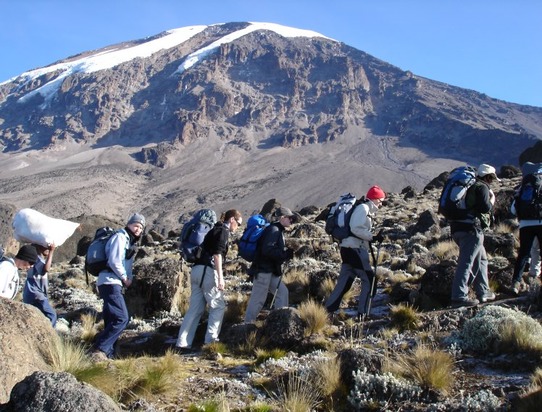Are you ready to take the challenge? Whenever you think Africa, you are unlikely to miss out its most impressive natural carnation – Mount Kilimanjaro! It took centuries and millenniums for Mother Earth to plan out the beautiful rugged terrains and stunning picturesque features of Africa’s highest mountain peak. Surrounded by the Savannahs of East Africa, climbing Kilimanjaro is a dream come true for all trekkers, mountaineers and adventure lovers. During the entire voyage you will also come across breath taking lava formations, mind numbing glaciers, refreshing rain forests and soothing heather moorlands.
The Kilimanjaro is a 5, 891.8 (or 19,330) foot high volcanic mountain and is a part of the Kilimanjaro National Park. The Strato Volcano Mountain can be divided into three cones: Kibo, Mawenzi and Shira. Both Mawenzi and Shira are extinct volcanoes. However, Kibo is dormant and have chances to erupt again. Water bodies around the mountain includes: Lake Chala in the Maasai region, the Lumi River in the Eastern sides and the Panagani River on its Southern side.
Climbing Kilimanjaro through the Lemosho or Shira Route
Conquer the Kilimanjaro from the West using several spectacular ascent and descent paths. Starting from the Lemosho grade, which is 2100 metres above the sea level, you can climb Kilimanjaro within seven days! The best months for climbing Kilimanjaro are from April to September.
However, the Machame route is considered to be the most scenic, but unfortunately it’s also the steeper route. The Rongai route is the easiest to climb and has the least scenic views. The overall climbing experience can be quite challenging than even the Himalayas because of low temperature, high elevation and occasional high winds.
Step by Step Kilimanjaro Climb
Once you arrive at the Kilimanjaro Airport, you would require travelling through the Arusha National Park to reach a base camp located at the foot of Mount Meru. Get refreshed and pack your bags with all necessary hiking and trekking stuffs before you step your foot on the luscious terrains of Mount Meru. Trail through the mossy jungle to reach the Shira Plateau and further to the Kibo Massif. Next, you would be taken into an Alpine Zone that will be full of rocks – the Lava Tower, followed by the amazing view of the Arrow Glacier. Once you have reached 18, 500 feet above the ground level, the real challenging part comes into play. Climb through the Uhuru Peak and feel like a winner with magnificent views of the sky and the icy African beauty. Lastly, exit through the Mweka gate to reach down towards your base camp.
Different faunas that would interact with during your journey: Black and White Colobus Monkey, Buffalo, Giraffe, Bushbuck, Elephants, Duikers and maybe even Leopards. Safarihub ensures secure and safe trekking right from initiation of the tour till its end.
Things you need to Keep in Mind before Climbing Kilimanjaro
- Hire a well experienced guide or trek leader who can also assist you with first aid, comply with the standards of Wilderness Medicine Society (WMS) and is also well acquainted with the ascents and descents of Mount Kilimanjaro.
- Carry Gamow Bags and Oxygen Cylinders for use in case of emergencies.
- Ask about portable toilets and carry one with you to avoid degradation of the mountain.
- Do not climb too high, too fast – chances of altitude sickness increases

